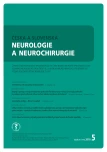Gamma knife stereotactic radiosurgery in recurrent or residual glioblastoma multiforme – our experience in two neurosurgical units
Authors:
R. Bartoš 1; O. Šoula 2; G. Šimonová 3; A. Malucelli 1; D. Šmejkalová-Musilová 4; F. Třebický 5; R. Liščák 3; J. Klener 2; M. Sameš 1
Authors‘ workplace:
Neurochirurgická klinika UJEP, Krajská zdravotní, a. s., Masarykova nemocnice v Ústí nad Labem, o. z.
1; Neurochirurgické oddělení, Nemocnice Na Homolce, Praha
2; Oddělení stereotaktické a radiační neurochirurgie, Nemocnice Na Homolce, Praha
3; Onkologické oddělení, Krajská zdravotní a. s., Masarykova nemocnice v Ústí nad Labem o. z.
4; Ústav radiační onkologie, Nemocnice Bulovka, Praha
5
Published in:
Cesk Slov Neurol N 2018; 81(5): 556-562
Category:
Original Paper
doi:
https://doi.org/10.14735/amcsnn2018556
Overview
This paper is a retrospective analysis of a 33 patient cohort with diagnosis of glioblastoma multiforme treated using gamma knife stereotactic radiation therapy following surgical resection and fractionated radiation therapy. Overall, 35 stereotactic radiation procedures were performed. Within this group, we differentiated patients who benefited from these procedures – we managed to stabilise or achieve remission of the disease in 13 cases (37%) in a 3 month follow-up and in 6 cases (18%) in a 6-month follow-up. Long-term remission of this highly malignant tumor using gamma knife therapy was achieved in 4 patients.
Key words:
gamma knife – glioblastoma multiforme – radiotherapy
The author declares he has no potential conflicts of interest concerning drugs, products, or services used in the study.
The Editorial Board declares that the manuscript met the ICMJE “uniform requirements” for biomedical papers.
Sources
1. Mahajan A, McCutcheon IE, Suki D et al. Case-control study of stereotactic radiosurgery for recurrent glioblastoma multiforme. J Neurosurg 2005; 103(2): 210 – 217. doi: 10.3171/ jns.2005.103.2.0210.
2. Shrieve DC, Alexander E 3rd, Wen PY et al. Comparison of stereotactic radiosurgery and brachytherapy in the treatment of recurrent glioblastoma multiforme. Neurosurgery 1995; 36(2): 275 – 284.
3. Hsieh PC, Chandler JP, Bhangoo S et al. Adjuvant gamma knife stereotactic radiosurgery at the time of tumour progression potentially improves survival for patients with glioblastoma multiforme. Neurosurgery 2005; 57(4): 684 – 692.
4. Imber BS, Kanungo I, Braunstein S et al. Indications and efficacy of gamma knife stereotactic radiosurgery for recurrent glioblastoma: 2 decades of institutional experience. Neurosurgery 2017; 80(1): 129 – 139. doi: 10.1227/ NEU.0000000000001344.
5. Frischer JM, Marosi Ch, Woehrer A et al. Gamma knife radiosurgery in recurrent glioblastoma. Stereotact Funct Neurosurg 2016; 94(4): 265 – 272. doi: 10.1159/ 000 448924.
6. Zwirner K, Paulsen F., Schittenhelm J et al. Prognostic parameters and outcome after re-irradiation for progressive glioblastoma. Acta Neurol Scand 2017; 136(3): 239 – 245. doi: 10.1111/ ane.12719.
7. Nwokedi EC, DiBiase SJ, Jabbour S et al. Gamma knife stereotactic radiosurgery for patients with glioblastoma multiforme. Neurosurgery 2002; 50(1): 41 – 47.
8. Souhami L, Seiferheld W, Brachman D et al. Randomized comparison of stereotactic radiosurgery followed by conventional radiotherapy with carmustine to conventional radiotherapy with carmustine for patients with glioblastoma multiforme: report of Radiation Therapy Oncology Group 93-05 protocol. Int J Radiat Oncol Biol Phys 2004; 60(3): 853 – 860. doi: 10.1016/ j.ijrobp.2004.04.011.
9. Irish WD, MacDonald DR, Cairncross JG. Measuring bias in uncontrolled brain tumor trials – to randomize or not to randomize? Can J Neurol Sci 1997; 24(4): 307 – 312.
10. Krex D, Klink B, Hartman C et al. Long-term survival with glioblastoma multiforme. Brain 2007; 130(10): 2596 – 2606. doi: 10.1093/ brain/ awm204.
11. Duma CM, Kim BS, Chen PV et al. Upfront boost Gamma Knife „leading-edge“ radiosurgery to FLAIR MRI – defined tumor migration pathways in 174 patients with glioblastoma multiforme: a 15-year assessment of a novel therapy. J Neurosurg 2016; 125 (Suppl 1): 40 – 49. doi: 10.3171/ 2016.7.GKS161460.
Labels
Paediatric neurology Neurosurgery NeurologyArticle was published in
Czech and Slovak Neurology and Neurosurgery

2018 Issue 5
- Memantine Eases Daily Life for Patients and Caregivers
- Hope Awakens with Early Diagnosis of Parkinson's Disease Based on Skin Odor
- Metamizole vs. Tramadol in Postoperative Analgesia
- Metamizole in the Treatment of Acute Postoperative Pain
- Metamizole at a Glance and in Practice – Effective Non-Opioid Analgesic for All Ages
Most read in this issue
- New insights in the diagnosis and treatment of amyotrophic lateral sclerosis
- Review of diseases with restricted diffusion on magnetic resonance imaging of the brain
- Cervical vertigo – fiction or reality?
- Anaesthesia and neuromuscular disorders
